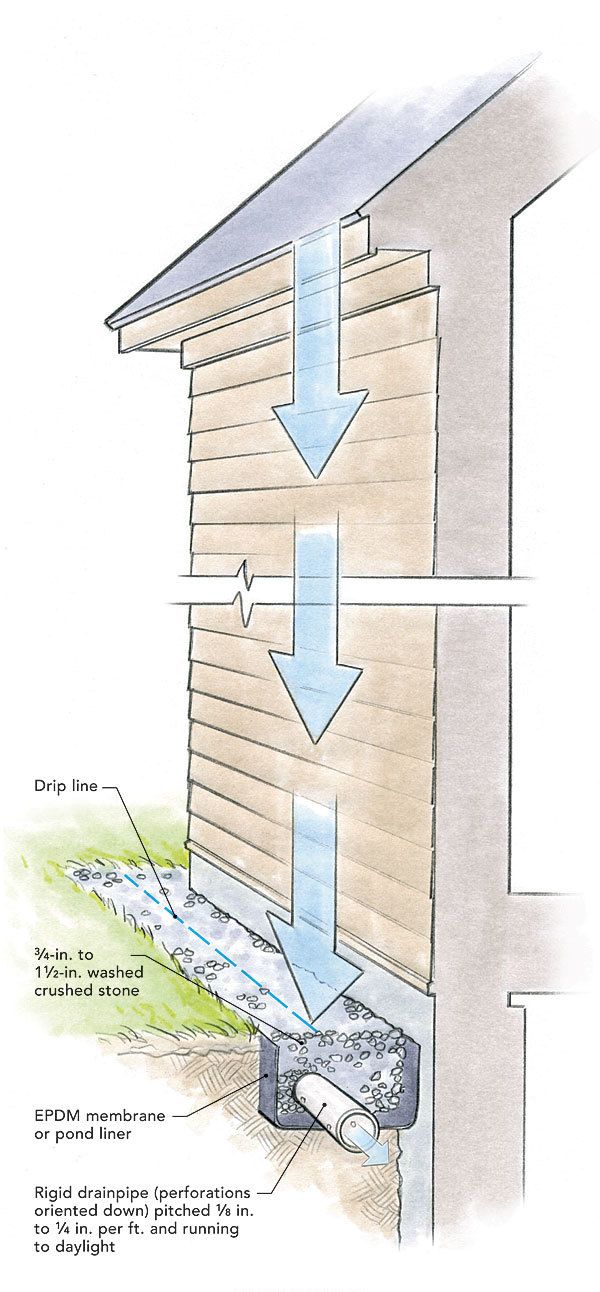Is There Any Alternative to Roof Gutters?
A ground-gutter system is a viable option.

Q:
I’m sick and tired of my gutters. They leak, they are rotting out my trim, they’re a maintenance headache, and on top of all that, I don’t like how they look. Without them, however, I’m concerned that my stone foundation will leak even worse than it does now. What should I do?
Rachel Dwyer, None
A:
Michael Maines, a residential designer in Palermo, Maine, replies: Rather than having a traditional gutter attached to the house, you can create a ground-gutter system, sometimes referred to as an inground gutter. It won’t help with groundwater getting into your basement, but it will perform most of the duties of a roof gutter without the aesthetic and maintenance drawbacks. We’ve done many of these setups over the years, and they work reliably if you pay attention to a few details.
The trench should extend from the foundation to a point about a foot or two past the drip line of the roof. It should start about 8 in. to 12 in. deep and slope at least 1⁄8 in. to 1⁄4 in. per ft. as it heads toward daylight. Line the trench with a waterproof membrane such as EPDM or polyethylene film. If your roof overhang is small or if you live in a high-wind area, you might want to attach the membrane to the foundation to capture rain washing down the side of your house.
In the bottom of the trench, place a 4-in.-dia. perforated drainpipe. I strongly recommend rigid pipe because it won’t hold sediment as easily as corrugated pipe and is more resistant to crushing. Orient the perforations in the pipe toward the bottom of the trench at approximately the 4:00 and 8:00 positions. This may seem counterintuitive, but you aren’t trying to catch rain coming from above; rather, you’re providing an easy outlet for rainwater as it fills up the trench. If the holes face up, then the water level has to rise above the pipe before finding the escape route.
You need perforated pipe only around the house; if you are running the drain to a dry well or away from the house, you can switch to solid pipe. I like to place the pipe where the rain is most likely to fall from the roof, just beyond the drip line, but I’m not sure that it makes a lot of difference.
With the pipe in place, backfill the trench with washed crushed stone. I’ve found that 3⁄4-in. stone works, but I prefer to use 1-1⁄2-in. stone because it stays in place better. You can add landscape fabric a couple of inches below the surface to keep debris out of the trench.
Maintenance on a ground gutter is virtually nil. Just check the outlet once in a while to make sure that it’s draining freely, and rake leaves off the surface of the stone in the fall. Including a cleanout or two isn’t necessary, but it’s a good idea. You can run a riser pipe up to grade and cover it with an unglued end cap, or you can use a plastic distribution box, which is also handy for tying in multiple drains to one outlet pipe.
My only caution is that ground gutters can create splash back, so if your siding is close to the ground, they may not be the best choice.





View Comments
Or you could just make sure the grade runs away from your house! however If your intent is to capture the water this should work well.